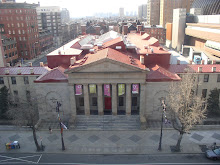
These instructions show you how to bind a book with an interesting pattern of weaving which laces the front and back covers to the spine. Hedi Kyle is responsible for re-creating this historical binding style currently attributed to the Belgians. The secret is that the text block is sewn together first, using tapes. The cover is then added using the stitching made over the tapes. Once the sewing is completed, the tapes are removed. It is difficult to see that the tapes were ever in place, which makes the binding process a real mystery when you examine the book.
This book takes time and patience. It is not a book for beginners. You must work carefully and precisely, but the final product is a gem!
The materials and tools needed are as follows:
You can click on any of the images to enlarge. I've provided a link below that provides some excellent instructions. I would suggest checking them out first and then refer back to the detailed images that I've provided below for a better understanding. Good Luck!
http://users.stargate.net/~dearsam/bookarts/
A good way to make equal measurements on your board (or sections) is to line the edge of your board (or paper) on a lined cutting mat. Then count up however many sections you want, and make a mark where each line intersects.
For example: counting up 9 marks will give you 8 holes and 9 sections (As seen below)

As you can see below, I only have 6 holes punched in my sections. This is because (for decorative purposes) I wanted 8 holes on my boards. The only holes that need to correspond between the sections and the boards are the ones where the tapes will be placed. The holes that are on the outer edges of your sections should be about 1/4 of an inch from the edge so that you don't have floppy corners - it won't matter that they don't line up with the holes on the boards.

Your tapes should be cut from a tightly woven product (such at Tyvek or Vellum) or one that easily slide in and out, since you will be removing them once the sewing is done.

Detailed view of adding the first section on with the tapes:

Each time you add a section you will make a linking stitch over the tapes to connect with the previous section.

Detailed view of the first two sections linked together:

This is what the sections should look like once all are linked together:

Hedi and Erin work on a sewing model for the boards before starting on the real book:

Working on a model for connecting the boards is a good idea to do before progressing to the real book so that you can better understand how the sewing will work.

It's easier to keep your tabs placed on the outside of your boards so that you can thread the needle through and see where you're going.



Now that you are attaching the boards, you should have the spine faced down towards the mat and be gliding your needle over the tabs and through to the other side. This means that your needle is going in between the thread that links your sections and the actual sections themselves. The tabs make it possible to separate the two and get the needle through there with ease.

Detailed view of the needle coming through to the other side:

Finished product: This book was a dummy and so I did not cover my boards. For more visually pleasing results you should cover your boards before poking the holes.



1 comment:
Hello MFA BookArts!
A fantastic tutorial, thanks for taking the time to make it. Just a quick one to let you know that I’ve added your tutorial as a resource in our latest ‘Top 10 Secret Belgian Binding Tutorials – http://www.ibookbinding.com/blog/top-10-secret-belgian-binding-tutorials/
Thanks again and keep up the good work!
~ Paul
Post a Comment